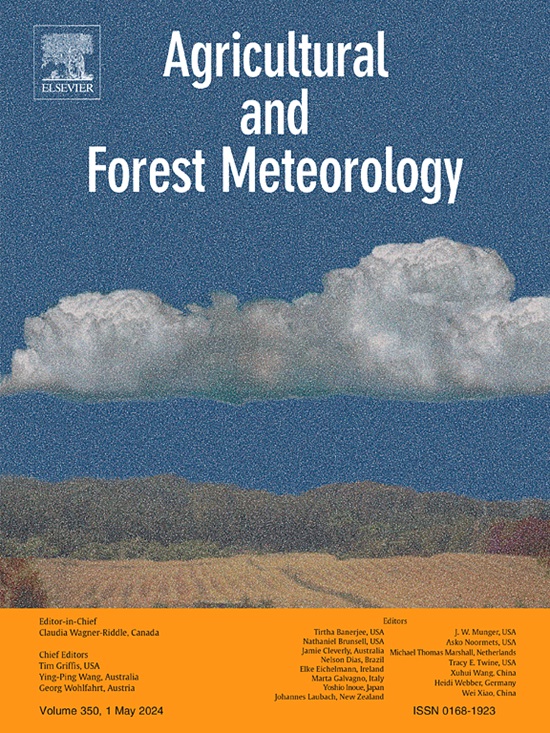西北落叶松人工林逐渐死亡阶段土壤水分阈值
IF 5.6
1区 农林科学
Q1 AGRONOMY
引用次数: 0
摘要
气候变暖导致的干旱胁迫加剧对旱地人工林造成了各种负面影响,包括生长减少、树冠枯死甚至树木死亡,对森林生态系统造成了不可避免的后果。然而,干旱胁迫如何逐渐导致成熟树木从生长减少到死亡的损害过程仍不清楚,特别是其不同的土壤湿度阈值。以华北落叶松(Larix principis-rupprechtii)人工林为研究对象,监测了2021年夏季极端干旱事件中树木的蒸腾、径向生长、叶面积指数、变色、落叶、树冠枯死和树木死亡率的变化。结果表明,落叶松对夏季干旱的响应较强,表现为茎干收缩大,蒸腾速率和叶面积指数急剧下降,部分地点出现明显的变色、落叶、冠枯和枯死现象。树木响应强度主要取决于土壤湿度而非气象因子,树木响应与0 ~ 60 cm层土壤相对含水量(RSW)有较强的相关性。根据树木对RSW的响应,确定了5个土壤干旱胁迫水平或渐进死亡阶段及其相应的RSW阈值:没有可检测到的水力限制(RSW>0.7,一级),持续的茎干收缩和开始的蒸干减少(0.45<RSW≤0.7,二级),开始的轻微变色和落叶(0.35<RSW≤0.45,三级),开始的树冠枯死和树木死亡(0.25<RSW≤0.35,二级),严重的落叶,树冠枯死和树木死亡(RSW≤0.25,二级)。研究表明,树木对气候干旱的响应受到土壤湿度的强烈调节,因此具有很强的立地特异性。这些发现将有助于评价气候干旱加剧下,特别是旱地地区人工林树木损害和死亡的程度和时空分布。本文章由计算机程序翻译,如有差异,请以英文原文为准。
Soil moisture thresholds at progressive mortality stages of larch plantations in the northwest China
Increasing drought stress due to climate warming has triggered various negative impacts on plantations in dryland areas, including growth reduction, crown dieback, and even tree mortality, with unavoidable consequences for forest ecosystems. However, how drought stress progressively led to the damage process from growth reduction to mortality for mature trees remains largely unclear, especially its varying soil moisture thresholds. Here we selected mature trees in larch (Larix principis-rupprechtii) plantations in the dryland areas of northwest China, and monitored the progressive tree responses in an extreme summer drought event in 2021, including transpiration, radial growth, leaf area index, discoloration, defoliation, crown dieback and tree mortality. The results showed strong responses of larch trees to summer drought, such as large stem shrinkage, dramatic decrease in transpiration and leaf area index, and obvious discoloration, defoliation, crown dieback and tree mortality at some sites. The intensity of tree responses mainly depended on soil moisture rather than meteorological factors and there were strong relationships between tree responses and relative soil water content (RSW) of 0–60 cm layers. Based on the trees responded to RSW, five soil drought stress levels or progressive mortality stages and their corresponding RSW thresholds were determined as following: no detectable hydraulic limitations (RSW>0.7, Level I), persistent stem shrinkage and onset of transpiration reduction (0.45<RSW≤0.7, Level II), onset of slight discoloration and defoliation (0.35<RSW≤0.45, Level III), onset of crown dieback and tree mortality (0.25<RSW≤0.35, Level IV), and severe defoliation, crown dieback and tree mortality (RSW≤0.25, Level V). This study showed that the trees responded to climatic drought were strongly regulated by soil moisture and thus were strongly site-specific. These findings will help to evaluate the degree and spatio-temporal distribution of tree damage and mortality in plantations under increasing climatic drought, particularly in dryland areas.
求助全文
通过发布文献求助,成功后即可免费获取论文全文。
去求助
来源期刊
CiteScore
10.30
自引率
9.70%
发文量
415
审稿时长
69 days
期刊介绍:
Agricultural and Forest Meteorology is an international journal for the publication of original articles and reviews on the inter-relationship between meteorology, agriculture, forestry, and natural ecosystems. Emphasis is on basic and applied scientific research relevant to practical problems in the field of plant and soil sciences, ecology and biogeochemistry as affected by weather as well as climate variability and change. Theoretical models should be tested against experimental data. Articles must appeal to an international audience. Special issues devoted to single topics are also published.
Typical topics include canopy micrometeorology (e.g. canopy radiation transfer, turbulence near the ground, evapotranspiration, energy balance, fluxes of trace gases), micrometeorological instrumentation (e.g., sensors for trace gases, flux measurement instruments, radiation measurement techniques), aerobiology (e.g. the dispersion of pollen, spores, insects and pesticides), biometeorology (e.g. the effect of weather and climate on plant distribution, crop yield, water-use efficiency, and plant phenology), forest-fire/weather interactions, and feedbacks from vegetation to weather and the climate system.

 求助内容:
求助内容: 应助结果提醒方式:
应助结果提醒方式:


